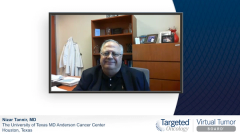
Single-Agent TKI Therapy in Favorable Risk Advanced Clear Cell RCC
Drs Tannir, Tykodi, and Ornstein debate whether single-agent TKI therapies still have a place in advanced clear cell RCC treatment, especially for favorable-risk patients.
Episodes in this series

Nizar Tannir, MD: To pursue this a little further, if the patient is young and healthy, is there an age cutoff or an age bracket, such as the patient being older than 75 years, in which you aren’t going to give a combination to a favorable-risk patient? Maybe a patient with pancreatic metastasis-only or other endocrine organ metastasis, when we know these are more angiogenesis-driven tumors and may respond very well to a single-agent TKI [tyrosine kinase inhibitor]. I agree that the response rate is going to be higher with the combination, as far as the ORR [objective response rate] and CR [complete response] rates. But when you look at the survival, all 4 regimens for favorable risk haven’t shown improvement in OS [overall survival]. Is there a patient for whom you’d prefer a single-agent TKI?
Moshe, you advocate following the patient with a close eye and deferring initiation of systemic therapy with your approach of observation and surveillance. If we think the patient doesn’t have to be treated quickly, is there a role for a single-agent TKI? Maybe in older patients or patients who you think may have a problem tolerating an immune checkpoint inhibitor?
Moshe Ornstein, MD, MA: I’d never say that there’s no patient for whom it would be appropriate. I’d push back a little [regarding] the survival benefit in the favorable-risk patients in the trials. That’s a very wide confidence interval for most of them. In reality, for a favorable-risk patient, no matter what you do, it’s going to take a long time to see a difference between 2 treatment options. Despite having relatively long follow-up, we probably won’t know the answer to that for some time, especially with axitinib and pembrolizumab. I go back to the idea that we’re trying to achieve complete responses, and if we aren’t going to achieve a complete response, we’d like to see at least a deep and durable partial response. Over the last 10 or 15 years of treating patients with single-agent TKIs, we generally don’t see that. It’s critical to have the addition of the IO [immunotherapy] for that.
Getting back to your original question, I don’t have an age cutoff for whom I’d give a combination. It’s less about chronological age and more about medical wellness and whether a patient is fit for therapy. But I worry about taking a patient who’s otherwise healthy, aside from a favorable-risk metastatic RCC [renal cell carcinoma], and giving them only a single-agent TKI. If it’s a patient who has small pancreatic metastases, we know those patients tend to do well in the long run, and I’d consider surveillance. Once that fork in the road is crossed where we’re deciding to treat, I give the combination with an IO agent as a backbone with a TKI. I’m curious to hear what Dr Tykodi does.
Nizar Tannir, MD: Scott, you have the floor.
Scott Tykodi, MD, PhD: It’s a great question. I generally start getting nervous that my patients in their 80s won’t have good tolerance to therapy, even if they’re relatively fit. I think about single-agent therapy, but I rarely go down the TKI pathway. I typically offer much older patients PD-1 blockade monotherapy because of my expectation that it’s the better-tolerated drug class. Then as you follow the patient’s progress, if they’re responding, you sit tight and you’re happy with your choice. If you aren’t satisfied with the response, you’d consider then adding the TKI on top of the PD-1 after 1 or 2 scans. You’re coming to the combination for need because of disease control. You hope that the patient does well with PD-1 monotherapy.
I only go down the targeted drug monotherapy pathway for patients with a strong contraindication to checkpoint immunotherapy. [Maybe] they have some concerning autoimmune history and you don’t want to go there, so you’d start with the TKI. That being said, I have many patients from before the checkpoint era who did wonderfully well on single-drug targeted therapy for many years, and some of them were quite older. It certainly can work, but I’ve often steered toward the IO drug for a single agent. When the age starts with an 8, I rarely start with a doublet. They’ve got to be pretty robust to [receive] standard therapy.
Nizar Tannir, MD: Fair enough. Thank you both for this wonderful discussion.
Transcript edited for clarity.










































